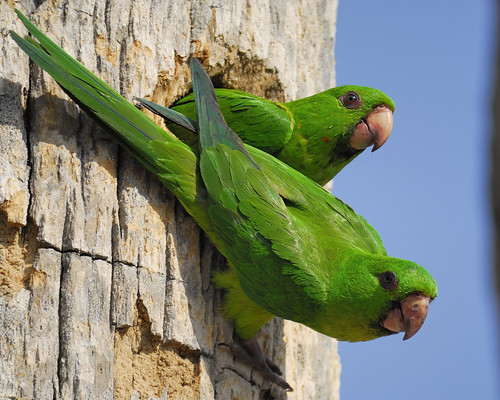tags: Green Parakeet, Green Conure, Aratinga holochlora, birds, mystery bird, bird ID quiz
[Mystery birds] Green Parakeets, also known as Green Conures, Aratinga holochlora, photographed at Elizabeth Street Parrotry, Brownsville, Texas. [I will identify these birds for you in 48 hours]
Image: Joseph Kennedy, 7 April 2008 [larger view].
Nikon D200, Kowa 883 telescope with TSN-PZ camera eyepiece 1/1000s f/8.0 at 1000.0mm iso400.
Please name at least one field mark that supports your identification.
The Green Parakeet, Aratinga holochlora, is a medium-sized parrot that is native to Central America, ranging from Mexico south to northern Nicaragua. These birds have established self-sustaining populations in some cities in southeast Texas in the United States. It is unclear if the US population are feral released birds or may instead be some wild vagrants which have moved north from Mexico. The Green Parakeet is usually nonmigratory, but will move sometimes to take advantage of food supplies. The Pacific Parakeet, formerly considered a distinct species, is now classified as a subspecies Aratinga holochlora strenua.
- Log in to post comments


Aratinga sp.
Good one Luis... this is Aratinga holochlora, Green Parakeet (or Mexican Green Conure), and although this photo is from what appears to be an aviary in Brownsville, TX, there are established self-sustaining populations of this species in Texas cities, either releases or having "migrated" North from Mexico...
mosly green (with occasional spots of yellow or orange, as in the top bird), horn-colored beak, bare eye-ring...
Is this shot actually from an aviary? Brownsville does have an established population, and I can see "Elizabeth Street Parrotry" being an informal name for a location to look for these birds. On the other hand, neither a google search nor a look at the Brownsville yellow pages produces a business with this name.
Of course, this photo and a related one of Red-crowned Parrots from the same location are all over the place.
Well psweet, I assumed Texans, as representatives of the culture of the US that likes to abuse the english language with disdain, used the term "parrotry" to imply some sort of aviary, but it appears that it is intended to mimic a "rookery" or "heronry" (the term "parrotry" in that sense does not exist, but "rookery", although derived from crows and rooks is accepted as referring to any bird nesting colony) because I have read reports that this particular location must be the palm trees outside a former Ramada Inn, and now a UT Brownsville dorm, on Elizabeth St.
Other species, in addition to the Red-crowned Parrot, that are thought to have self-sustaining populations in the Brownsville area include the Yellow-headed Parrot and the Monk Parakeet.
these are not aviary birds; they are wild birds, whether escapees, releases or migrants (many think they are migrants, so i'd guess they are a mixture of the three possibilities), is not known. but they nest in this area quite nicely. i've shown other pictures from this same area in the past of other parrot species that nest in this area as well.
My understanding of the argument for some of these birds being wild birds is that there is some fluctuation in numbers that correlates with fluctuations in nearby Mexico, in such a way as to suggest that some of the birds that disappear down there must be coming up to Texas.
Given the lack of ornithological interest by the conquistadors, and the changes that we know have occurred in the lower Rio Grande, it wouldn't surprise me if there were originally wild parrot populations along the river. Don't know if we'll ever be able to say for sure, though.